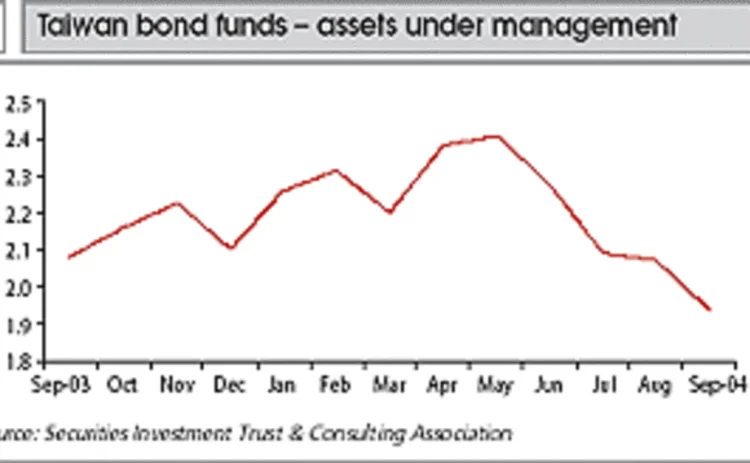
Grinding to a halt in Taiwan
Following new investment regulations issued by the Securities and Futures Bureau last year, dealers are concerned that Taiwan’s structured products market is coming to a standstill. Jill Wong reports

Taiwan’s structured products market has been hit hard by new regulations prohibiting the country’s bond funds from investing in structured notes. Dealers say that demand from domestic funds – huge buyers of structured bonds over the past few years – has dried up since the Securities and Futures Bureau (SFB) issued the ruling in September 2004.
Under the guidelines, bond funds are not allowed to make any new investments in structured interest rate products, including structured bonds and structured deposits. The move follows turmoil in the market in July, when the default of technology firm Procomp Informatics caused a rush of bond fund redemptions by investors. The total market value of domestic bond funds dropped to NT$1.94 trillion ($59 billion) at the end of September 2004 from a peak of NT$2.41 trillion at the end of May (see chart, p.26). However, the illiquidity of the domestic bond market – particularly for structured bonds – meant that a number of funds were unable to keep up with redemptions, leading to the near collapse and eventual takeover of United Securities Investment Trust by Fubon Securities Investment Trust.
“The regulation targets new investments in structured products, but we have no regulation that compels them to sell their existing holdings of structured products,” says an official at the SFB in Taipei. However, the SFB will probably issue more guidelines relating to bond funds towards the end of the year, she adds, declining to give further details.
The country’s bond funds have snapped up billions of dollars in structured bonds in recent years, particularly quanto US dollar Libor inverse floating-rate notes, which aim to take advantage of low interest rates by taking a relatively high fixed-rate and subtracting six-month Libor. However, four quarter-point hikes in US interest rates this year, taking it from a 46-year low of 1% to 2%, means that these products are looking less attractive.
Nobuyuki Murase, a global fund ratings analyst with Moody’s Investors Service in Japan, estimates that some 10%–35% of Taiwan bond funds’ portfolios are invested in structured products. Given the rise in interest rates, the new regulation will be positive for Taiwan’s bond funds from a market risk perspective, he says. “In the long-term, this [regulation] might be good because structured products like inverse floaters or range accruals are not marked-to-market, so the potential loss is not expressed in the share price or net asset value,” he adds. “But if the funds cannot invest in those structured products anymore, the potential risk will be lower.”
A dying breed
Dealers say the structured products business has virtually come to a halt since the SFB’s announcement. One head of fixed income at a global bank in Hong Kong says: “After the new regulation was issued in September, the Taiwan dollar quanto market is now totally dead. We will try to find other products that don’t fall under the regulations, and focus on selling structures to those that can still buy.”
Another Hong Kong-based banker adds: “The structured bonds business has died down quite a lot since the new regulation. Some bond funds are trying to unwind their positions, and are looking to sell the structured bonds back to the issuers, but not many issuers are willing to buy back the bonds due to drop in net asset values.”
Bond funds have, until recently, been prohibited from using the over-the-counter derivatives to hedge (see box, p.26). As such, fund managers wanting to unwind structured bond investments have had to look at alternatives. Some banks, for instance, are buying quanto inverse floaters and range accruals from bond funds and repackaging them into credit-linked deposits with alternative coupon payouts.
However, not all fund managers are looking to sell. “Structured bonds and structured deposits have brought enhanced yields to bond fund managers. On the other hand, if they sell these products, the performance of bond funds may be adversely affected,” says Cindy Lin, a bond fund manager at Capital Investment Trust in Taipei, who heads a team that manages three funds worth NT$115 billion. “For us, we bought our structured bonds and structured deposits at a low cost, and given that our bond fund size is stable and the Taiwan commercial paper rate is likely to rise faster than US Libor, we don’t see a need to sell these instruments in exchange for more liquidity.” Around 50% of Lin’s funds are invested in straight bonds, 20% in structured bonds, 20% in structured deposits and the rest in repos and time deposits. Most of the structured bonds still pay a higher rate than fixed-rate domestic bonds, she adds.
Another bond fund manager, Taipei-based Amy Li at Prudential Financial Securities Investment Trust, says the new regulation poses little concern for her, as her fund is not a big buyer of structured products. “Taiwan bond funds have very different investment portfolios. Not every bond fund is heavily invested in structured bonds,” she says. “We have some structured bonds, but most of our bond funds are invested in straight bonds and other assets such as cash and bond repurchase agreements.” Li, who manages a NT$28 billion bond fund, says 41% of her portfolio is invested in straight bonds, with “very little” in structured products.
The September regulations state that those investment trust companies that intend to invest in structured products can apply to launch “new types of fixed-income securities funds”. Thomas McGowan, a Taipei-based foreign legal consultant with law firm Russin & Vecchi, says that this reflects the intention of the regulator to give recognition to different types of fixed-income funds. “The key thing that’s been recognised in the September 21 ruling is that there will be different kinds of fixed-income funds, and the regulator is starting the process by saying that if a securities investment trust company wants to create a fund that will invest in structured deposit-type products it can do so, but the investment trust company is not allowed to call it a bond fund so one does not confuse the market.”
McGowan says that he expects to see further actions relating to money market funds, and also to distinguish between different types of fixed-income funds. “The other step that I’m sure is coming is that we’ll end up with real money market funds that are limited to investing in short-term liquid securities. So we’ll end up with money market funds, bond funds and some kind of structured debt funds.”
| Bond funds and the OTC market |
Taiwan’s bond funds can now use the over-the-counter (OTC) derivatives market to hedge following a change in regulations in August by the GreTai Securities Market, the body overseeing the country’s OTC market. Securities firms can now apply to trade ‘contracts derived from money market interest rates’, including forward-rate agreements, and interest rate swaps and options. However, if the derivatives contract is packaged with other financial products, these will need to be individually approved. To qualify for a Taiwan dollar derivatives trading licence, securities firms must have a long-term credit rating of at least twBB- from the Taiwan Ratings Corporation, BB- from Fitch Ratings, Ba3.tw from Moody’s Investors Service or BB- from Standard & Poor’s. There are also limits on the total principal amount of Taiwan dollar derivatives contracts outstanding, depending on the firm’s long-term credit rating. For A-rated firms, the limit is four times the firm’s net worth. The move follows turbulence in Taiwan’s bond market in July, when a rush of redemptions by corporate and institutional investors caused several bond funds to come close to collapse. Part of the problem was caused by the high proportion of structured bonds – for which there is no liquid secondary market – held by funds. Bond funds are now prohibited from making new investments in structured bonds, but with interest rates on the way up – meaning the returns offered by inverse floaters will fall – the new regulations give fund managers an avenue to hedge their existing structured bond holdings. In practice, market participants say structured notes are held mostly for their returns and a lot of them remain unhedged. “At the moment, hedging by bond funds is done mainly using interest and bond futures, which are quite limited. The regulator is expected to come up with a list of instruments that we can use for hedging, and we are waiting for that,” says one bond fund manager in Taipei, adding that he has not yet used OTC derivatives to hedge his structured note holdings. Observers say that bond fund managers are more accustomed to aggressively building up the net asset value (NAV) of their funds and are not yet used to hedging. |
Only users who have a paid subscription or are part of a corporate subscription are able to print or copy content.
To access these options, along with all other subscription benefits, please contact info@risk.net or view our subscription options here: http://subscriptions.risk.net/subscribe
You are currently unable to print this content. Please contact info@risk.net to find out more.
You are currently unable to copy this content. Please contact info@risk.net to find out more.
Copyright Infopro Digital Limited. All rights reserved.
You may share this content using our article tools. Printing this content is for the sole use of the Authorised User (named subscriber), as outlined in our terms and conditions - https://www.infopro-insight.com/terms-conditions/insight-subscriptions/
If you would like to purchase additional rights please email info@risk.net
Copyright Infopro Digital Limited. All rights reserved.
You may share this content using our article tools. Copying this content is for the sole use of the Authorised User (named subscriber), as outlined in our terms and conditions - https://www.infopro-insight.com/terms-conditions/insight-subscriptions/
If you would like to purchase additional rights please email info@risk.net
More on Markets
Banks mull whether to stick or twist with SDPs
Fewer providers are going all-in on single-dealer platforms, which may lead to consolidation
Market for ‘orphan’ hedges leaves some borrowers stranded
Companies with private credit loans face punitive costs from banks for often imperfect hedges
Green knights? Banks step into struggling carbon credit markets
Clearer global standards and a new exchange may attract dealer entry, but supply and demand challenges remain
Morgan Stanley back on top for US insurer FX forwards trades
Counterparty Radar: Bank added $1.7bn with Mass Mutual in Q4 to overtake Citi as biggest dealer
Euronext microwave link aims to cut HFT advantage in Europe
Exchange plans to level playing field between prop firms and banks in cash equities with cutting edge tech
As dispersion hikes in price, equity traders slice and dice
Banks tout alternative versions of relative value vol strategy, including reverse dispersion
Crédit Agricole hires head of USD swaps and UST trading
John O’Callaghan joins French bank in New York from Garda Capital
Hidden Road ready for rush hour after FCM approval
Prime broker is trading “trillions” of notional with “a few hundred” counterparties in FX and crypto
Most read
- Top 10 operational risks for 2024
- The American way: a stress-test substitute for Basel’s IRRBB?
- Hidden Road ready for rush hour after FCM approval







